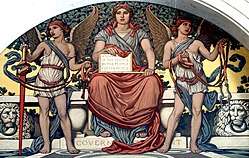Canadian public debt
| Public finance |
|---|
 |
|
Reform |
The Canadian government debt, commonly called the "public debt" or the "national debt", is the amount of money owed by the Government of Canada to holders of Canadian Treasury security. In 2014, this number stood at CAD$1.4 trillion across federal and provincial governments. With the total GDP somewhere around CAD$1.8 trillion, Canada's overall debt/GDP ratio is around 77%. "Gross debt" is the national debt plus intragovernmental debt obligations or debt held by trust funds. Types of securities sold by the government include treasury bills, notes, bonds, Real Return Bonds, Canada Savings Bonds, and provincial government securities.
The annual government "deficit" is the difference between government receipts and spending.
Revenue and spending
History
Canada's federal debt grew steadily between 5% and 10% per year until 1975. For the next 12 years it grew on average over 20% per year. It surpassed $100 billion in 1981, $200 billion in 1985, $300 billion in 1988, $400 billion in 1992, and $500 billion in 1994. It peaked at $563 billion in 1997, before then declining to $458 billion by 2008.
With a recession, and an increase in federal spending from 2008, the federal debt grew by $5.8 billion in 2008–09. Large annual deficits from 2008 to 2013 has Canadian debt surpassing the $600 billion mark by November 2012, making it larger than the 1997 peak in absolute dollars (although far smaller in comparison to GDP). Starting in 2014, Canada returned to balanced budgets and has posted a small surplus (despite the debt continuing to increase in the following table).
| End of Fiscal Year |
Net Debt $Billions[1] (Adjusted for |
as % of GDP |
GDP $Billions[3] |
|---|---|---|---|
| 1962 | 14.8 (121.4) | 33.0% | 44.9 |
| 1971 | 20.3 (126.1) | 20.6% | 98.4 |
| 1981 | 91.9 (240.2) | 25.5% | 360.5 |
| 1991 | 377.7 (592.0) | 55.1% | 685.4 |
| 1997 | 562.9 (811.1) | 63.8% | 882.7 |
| 2002 | 511.9 (664.2) | 44.4% | 1,152.9 |
| 2008 | 457.6 (515.3) | 31.4% | 1,453.6 |
| 2009 | 463.7 (495.1) | 32.8% | 1,413.3 |
| 2010 | 519.1 (579.5) | 35.5% | 1,458.8 |
| 2011 | 551.4 (599.19) | 36.9% | 1,495.7 |
| 2012 | 583.6 (626.4) | 38.3% | 1,576.8 |
| 2013 | 609.4 (645.5) [4] | 37.4% | 1,608.5 |
| 2014 | 611.9 (634.78) [5] | 37.1% | 1,649.2 |
| 2015 | 612.3 (627.21) [5] | 31.0% | 1,975.2 |
| 2016 | 616.0 (623.17) [6] | 31.0% | 1,987.1 |
| 2017 | 631.9 | 31.2% | 2,025.3 |
Foreign ownership
In 1960, 4% of the Canadian government debt was held by foreign investors.[7]
From 2009-2010 to 2013-2014, the amount of the Canadian's debt held by foreign investors passed from 15% to 27% with a peak at 30% in 2012-2013. Even if growing, this level is still lower than most G7 countries in 2013-2014 (France, 64%, Germany, 62%, United States, 48%, Italy, 33%, United Kingdom, 29% and Japan, 8%).[8][9]
Debt held by Canadian governments
The Royal Bank of Canada publishes records of federal and provincial debt figures going back to 1981.[10]
A comparison of the change in debt-to-GDP ratios of the provinces over a nine year period, as reported by the Fraser Institute.[11]
| Government | Percent of Debt to GDP for the Fiscal Year 2007/2008 | Percent of Debt to GDP for the Fiscal Year 2016/2017 | Percent Increase between 2007-2017 |
|---|---|---|---|
| British Columbia | 12.1 | 15.1 | 25.2 |
| Alberta | -13.4 | 3.3 | 124.7 |
| Saskatchewan | 11.2 | 11.5 | 2.9 |
| Manitoba | 21.2 | 34.1 | 60.7 |
| Ontario | 26 | 40.2 | 54.5 |
| Quebec | 40.6 | 48.1 | 18.4 |
| New Brunswick | 25 | 42.4 | 69.8 |
| Nova Scotia | 35.7 | 36.9 | 3.4 |
| Prince Edward Island | 29.1 | 34.7 | 19.1 |
| Newfoundland & Labrador | 35.1 | 49.5 | 41.3 |
| Federal | 32.8 | 36.1 | 10.1 |
| Combined Federal & Provincial | 53 | 67.5 | 24.5 |
Calculating and projecting the debt
In 2002–2003, Canada changed its calculation for net debt. Before this, net debt was defined as the total liabilities minus total assets; now it is the total liabilities minus financial assets, as the government prefers the concept of "accumulated deficit", which corresponds to the old definition of net debt.
Advocacy Groups
Generation Squeeze is a Canadian not-for-profit organization advocating for intergenerational equity.
See also
General:
International:
Notes
References
- ↑ Canada's Debt History Archived 26 October 2009 at the Wayback Machine. Canadian Taxpayers Foundation
- ↑ Inflation Calculator Bank of Canada
- ↑ World Bank data
- ↑ http://www.fin.gc.ca/afr-rfa/2014/report-rapport-eng.asp
- 1 2 http://www.fin.gc.ca/afr-rfa/2015/report-rapport-eng.asp
- ↑ http://www.fin.gc.ca/afr-rfa/2017/report-rapport-eng.asp
- ↑ Safaraian, A.E. The Hegemony of International Business, 1945–1970, Volume IV: Foreign Ownership of Canadian Industry. New York: Routledge, 1973. 12.
- ↑ Department of Finance Canada, Debt Management Report 2011–2012, http://www.fin.gc.ca/dtman/2011-2012/dmr-rgd1201-eng.asp#Toc340732968
- ↑ Department of Finance Canada, Debt Management Report 2013–2014, http://www.fin.gc.ca/dtman/2013-2014/dmr-rgd1401-eng.asp#toc12
- ↑ "Canadian Federal and Provincial Fiscal Tables" (PDF). Economic Reports. Royal Bank of Canada. Retrieved 17 March 2018.
- ↑ Lammam, Charles; MacIntyre, Hugh; Ren, Feixue; Hasan, Sazid (January 2017), The Cost of Government Debt in Canada, 2017 (PDF), Fraser Institute Research Bulletins, Fraser Institute, p. 16, ISSN 2291-8620
External links